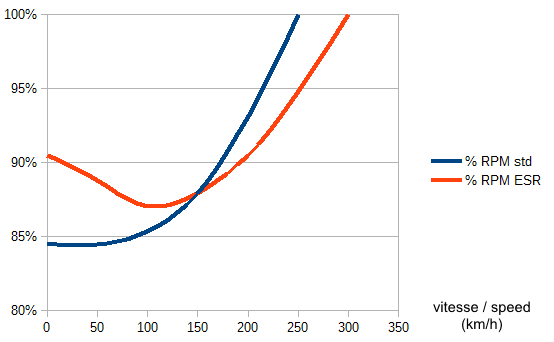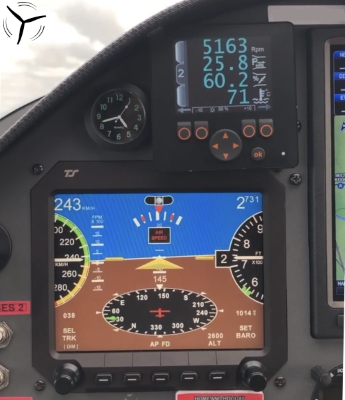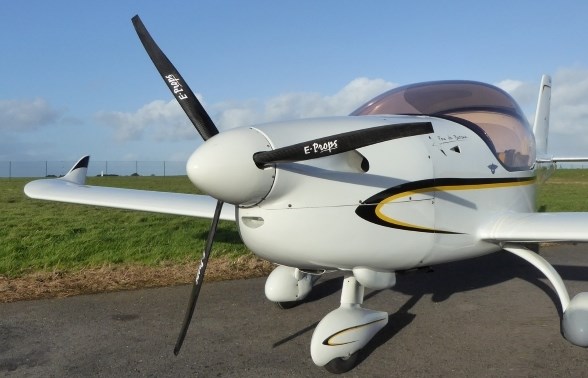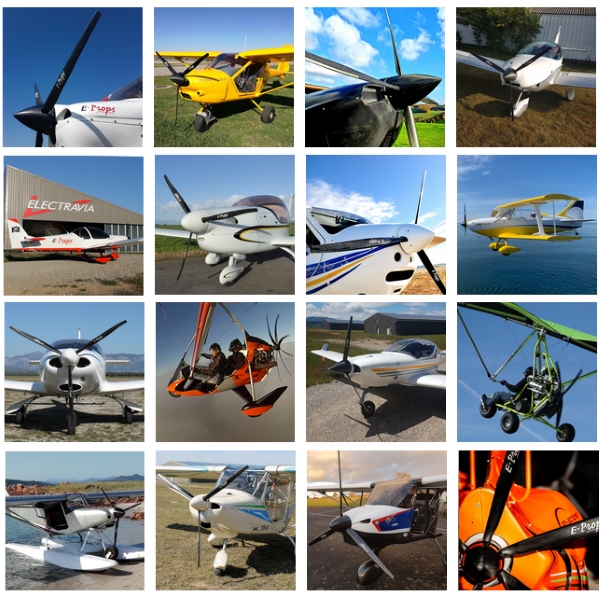EXTENDED SPEED RANGE (ESR) EFFECT
At E-PROPS, the term "ESR effect" is used to refer to a fixed pitch (or ground adjustable pitch) propeller whose behavior is very close to that of a variable pitch propeller, i.e. a strong thrust at all engine RPM.
This ESR effect has the following characteristics: it induces very little gap between the static rpm and flight rpm, which makes it possible to maintain high power at takeoff. Thanks to the hollow profiles, capable of more lift, the blades are not stalled, and therefore it allows to have a very strong take-off thrust.
Don't forget: what makes the plane take off, and what we are looking for, is not engine RPM, but thrust
With an ESR effect propeller, the full throttle engine speed remains almost constant.
But beware: just because a propeller keeps the same RPM all the time doesn't necessarily mean it has the right efficiency...
=> A propeller can be "Constant Speed" without having this ESR effect, whereas a propeller with ESR effect is necessarily "Constant Speed".
Some examples :
- take-off : engine full throttle 5400 RPM
- max speed 200 km/h : engine full throttle 5500 RPM
In this case, the gap between 0 km/h and 200 km/h is only 100 RPM.
For comparison purposes, a standard propeller (not ESR) can have a gap up to 1000 RPM between take-off and max cruise speed.

very fast aircraft : JMB VL3 with Rotax 912S
Example for a ROTAX 912 engine, pitch adjusted for 5800 RPM at 120 km/h :
- a propeller without ESR Effect will have between 600 and 1000 RPM less at take-off, and its thrust will be lower than 185 kg.
- an E-PROPS with ESR effect will allow to have only 200 RPM less at take-off (5600 RPM) : it means a static thrust of 210 kg (10 % more!)
The ESR effect can improve the performances at take-off, because then the engine is running very near of its max RPM, and provide all its power during take-off.
Some E-PROPS models allow to have more RPM at take-off than in flight...
From technical point of view, there are different solutions to obtain this ESR effect :
- narrow chord with classic profiles
- pitch reduction at low speed by blades deformation (difficult to obtain)
- narrow chord with special profiles, in order to avoid the stall of the blades => it is the case of the E-PROPS
Increasing the diameter reduces the ESR effect. Decreasing the number of blades restores the ESR effect.
COMPARATIVE CURVES (THRUST and RPM)
between an E-PROPS ESR effect propeller and a standard propeller

in thrust % (100% = an optimal variable pitch propeller)
the thrust of the E-PROPS propeller with ESR effect is always above the thrust of a standard propeller

indicated RPM in % of the maximum engine RPM during take-off,
the RPM of the E-PROPS propeller with ESR effect is always above a standard propeller
between an E-PROPS ESR effect propeller and a standard propeller

in thrust % (100% = an optimal variable pitch propeller)
the thrust of the E-PROPS propeller with ESR effect is always above the thrust of a standard propeller

indicated RPM in % of the maximum engine RPM during take-off,
the RPM of the E-PROPS propeller with ESR effect is always above a standard propeller
In the case of stalled blades, the loss of performance may be higher than the power gain.
Therefore, optimization of the curve "max thrust / speed" is essential when designing the propeller.
When attempting to reduce an aircraft’s take-off distance, thrust between 40 and 80 km/h is much more important than that between 0 and 40 km/h :
- while the aircraft is increasing from 0 to 40 km/h, its average speed is only 20 km/h; the distance made remains low (ex: 16 m in 3 sec)
- between 40 and 80km/h, the average speed is 60 km/h: this is where the runway length is "consumed" (ex: 60 m in 3.5 sec)
For E-PROPS propellers, static thrust measurement is not relevant, as they are designed to achieve full thrust during take-off, not in static.

(click on the image to open it in full size)
JMB VL3 engine Rotax 912S 3-blade propeller DURANDAL-3 ground adjustable pitch
TAS = 276 km/h / RPM = 5410 / MAN = 26.2 inch / ALT = 1570 ft

(click on the image to open it in full size)
PIPISTREL VIRUS SW engine Rotax 912S 3-blade propeller DURANDAL-3 ground adjustable pitch
TAS = 243 km/h / RPM = 5163 / MAN = 25.8 inch / ALT = 2731 ft
Thanks to their geometries anf their profiles, the E-PROPS have a very strong ESR effect, which allows to considerably improve the performances of the aircraft at take-off and in cruise, in comparison with all standard fixed pitch, and even with some variable pitch propellers.

a ground adjustable pitch E-Props propeller better than an inflight variable pitch propeller
For example, see the Comparative Test Report : E-PROPS / Variable Pitch Model
See many other tests reports showing the ESR effect here : E-PROPS : TESTS IN FLIGHT
Any questions about this ESR effect? Contact our design office => helices@e-props.fr





